En route to the farm, as I drive along the sun-speckled tree-lined road dense with late summer foliage, passing the calligraphed street signs, I feel as if I am going through a portal to another world. I had never been to this part of the island. It’s like a hidden jewel.
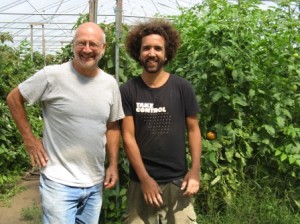
Owner Stephen Homer and business partner Alex of La Ferme du Zephyr
Stephen Homer, owner of La Ferme du Zephyr, agrees. “Most people don’t know about it, except for the bicyclists.” Amazing what is just under our noses. The road leads behind the Morgan Arboretum, which makes sense, really, since the land Stephen is farming is rented from the Morgan family. It is his fifth plot of land to farm, and according to him, his last. He has found a good fit here.
Stephen’s first farm was near Chambly on land owned by his aunt. At the time, he was a professional photographer, but after twenty years was becoming jaded with the industry. Since growing up next to a dairy farm, working the land had been a childhood dream. He talked to some restaurants and found they would be very interested in getting local baby vegetables, things like arugula, which, at the time, was quite exotic. Thus began his business. Soon, not only the restaurants were asking for his produce, but the customers as well. That was back in 1996. Now he has dropped the restaurants and concentrated on selling only to private customers – through CSA baskets.
When I first arrived at the farm, I was greeted by Jane “the herb lady”. Jane had started at Zephyr as a customer, became a volunteer, then in her semi-retirement asked to take
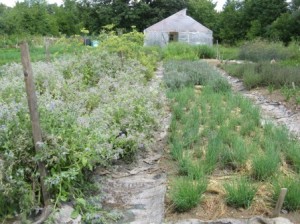
La Ferme du Zephyr’s herb garden
responsibility for the herb portion of the farm. Through Stephen’s guidance and her nurturing care, the herb garden has flourished. She handed me a leaf of sorrel to taste; deliciously citrusy and tangy. Next to that sat bunches of basil and chocolate mint. The heady aromas continued to scent our discussion as Stephen and I sat nearby to talk and he, to eat a well-earned lunch. Stephen likes herbs and vegetables that are lesser known, a way to get customers to open their horizons and taste buds. Later, on my walk through the herb garden, I spotted French thyme, lavender, rosemary, chives, lemongrass, and several others I didn’t recognize.

Flower garden at La Ferme du Zephyr
Carol (also known as the “flower lady” for her magnificent flower garden that sits adjacent to the herbs) heads up a project that offers original organically grown seedlings (ever heard of a Poona Kheera cucumber?), a vast array of herbs and several varieties of heirloom tomatoes, all for planting in your own garden. Each Spring, gardeners can purchase the seedlings on-line through the Co-op Maison Verte website, choosing from just under 100 varieties.
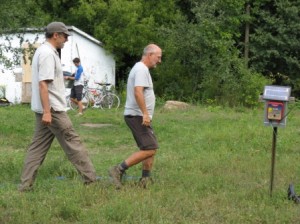
Howard Reitman and Stephen Homer
The surprises don’t end there. This year, Zephyr has given over an acre of land to Howard Reitman, Director and Mentor of Santropol Roulant’s peri-urban Farm Project. The vegetables from the farm (in conjunction with their two urban farm sites) are used in their three community outreach programs: Meals on Wheels, Fresh Baskets, and Neighborhood Markets. The organization also brings busloads of school children out to visit the farms and learn where their food comes from.[i] The students tour the Santropol Roulant’s field, the Zephyr farm, as well as the farm over at McGill College, just over the rise.
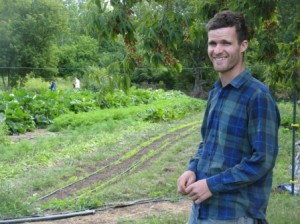
Sam and the Santropol Roulant peri-urban farm site
It’s enough to make your head spin. It’s strange: there is a peaceful quality to the farm, and yet you feel there is life here, movement, a low hum. The sound of bees and crickets; of tractors in the distance. The breeze through the trees. There are no cars, nor traffic, no radios blaring, or loud voices. Perhaps it’s just the organic sounds of nature that create that sense of peaceful activity. A welcoming change from the frenzied energy of urban life.
La Zephyr is an organic farm (as are the majority in the CSA movement), and I guess you could say that Stephen grows his farm organically as well. Volunteers come and go, certain interests, like the herb garden, take root and sprout, and even partnerships develop. Another change for the farm this year is Alex. He also began as a volunteer, and was so taken with the farm that he’s become the “front man”. The way he describes it, “Stephen is the cook, and I’m the waiter.” You will find him at market locations (NDG and Pointe-Claire) on the appointed days. He is also responsible for the farm’s Facebook page. Stephen is teaching him about farming and Alex is helping with the social media and marketing.
While I was visiting the Zephyr’s Pointe-Claire drop off point, Yasmeen, a customer from
Beaconsfield, was purchasing vegetables with her Fidelity Card, an option for La Ferme du Zephyr members who don’t like the constraints of a weekly basket. She often travels in the summer, so the Fidelity Card was a perfect solution. That is why she switched to Zephyr.
Other customers were adding to their weekly baskets, and a few others were just passers-by discovering the market for the first time. One of the benefits of the Pointe-Claire location is the foot traffic, bringing in potential customers every week.
Are you ready to try a CSA-basket? If you’re still undecided, here are some points to think about:
- The basket price varies, usually 20$-30$/week (paid in advance of the season). You can start with a small one, or bi-weekly, and benefit from a portion of your vegetables being organic and fresh. Then supplement at your regular grocery.
- Eating in season and from your local farmer means you get vegetables when they’re ripe and at their height of taste and nutritious value. As soon as fruits and vegetables are harvested, they start decreasing their vitamin and mineral content. And flavor as well.
- Eating a varied diet ensures that you get enough of all the necessary vitamins and minerals. When we stick to the same foods every day, we may be missing out on some of the necessary nutrients. By subscribing to a CSA basket, it nudges us into the direction of variety, by trying out the vegetables the farm has to offer. And most farms offer an exchange basket, so you can switch out one or two items that are really not to your taste.
- Becoming a member of a farm gives you a chance to be part of a community and to
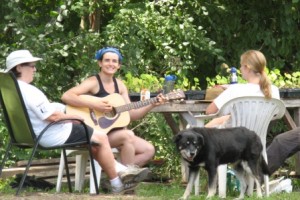
lunch break at the farm
experience the farm first hand. Most farms accept volunteers or interns, helping with harvests and planting. An excellent way for an apartment dweller to exercise his/her green thumb! At Zephyr, one volunteer gives 85 hours of her time to the farm (about 4 hours a week during the growing season), in exchange for a weekly basket.
To find a CSA basket locality near you, go to Équiterre’s website. Their interactive map allows you to choose a farm by drop-off point, and other criteria such as “fruits, vegetables, or meat” (the page is in French only). The 2012 season is half over, but some farms have market stands where you can buy as you go, or a Fidelity Card, where you pay in advance, then receive a discount on the produce until the end of the season.
Most farms end their season around October, but some offer winter baskets of root vegetables and certain greenhouse varieties. Zephyr has no winter basket, but is keeping their market stands open until before Christmas, supplying them with their greenhouse-grown fare.
For more information, go to La Ferme du Zephyr’s website, or their facebook page or visit them at:
Coop La Maison Verte, 5785 Sherbrooke ouest, Montreal (see map)
(NDG district)
• Thursdays: 3 – 7 pm.
Coop des Bons Voisins, 247a Lakeshore Road, Pointe Claire (see map)
(in front of the post office)
• Tuesdays from 3 – 7 pm.
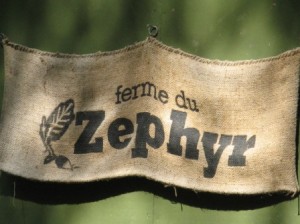
[i] The Dirt on It, a blog about the four farms sharing the same land: La Ferme du Zephyr, Santropol Roulant, Les Jardins Carya and MacDonald Student-run Ecological Gardens (MSEG)

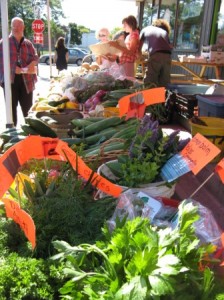
 scene below. I watch the people play: Men and women, young and old, a diverse mix of ethnicities and cultures. I start feeling the rhythm, but I still hesitate.
scene below. I watch the people play: Men and women, young and old, a diverse mix of ethnicities and cultures. I start feeling the rhythm, but I still hesitate.

 establishing a rhythmaculture in our Western world. People attend these events not to become better percussionists, but to reduce stress, build community, and have fun. It is a recreational activity that engages the mind, body, and spirit. Arthur Hull, father of the modern day drum circle, developed his unique approach to facilitating drum circles in the 1980s through an observation of the need that extended beyond percussion skill development. According to Arthur, “when we drum together, it changes our relationships and helps us cope with whatever challenges life hands us.”
establishing a rhythmaculture in our Western world. People attend these events not to become better percussionists, but to reduce stress, build community, and have fun. It is a recreational activity that engages the mind, body, and spirit. Arthur Hull, father of the modern day drum circle, developed his unique approach to facilitating drum circles in the 1980s through an observation of the need that extended beyond percussion skill development. According to Arthur, “when we drum together, it changes our relationships and helps us cope with whatever challenges life hands us.” empanada with a chipotle mayonnaise. There were three choices of salsa: a sweet mango salsa, a hot tomato salsa, or a medium with yellow and red tomatoes. While waiting to place your order, you could sample from one of the three colorful pots.
empanada with a chipotle mayonnaise. There were three choices of salsa: a sweet mango salsa, a hot tomato salsa, or a medium with yellow and red tomatoes. While waiting to place your order, you could sample from one of the three colorful pots.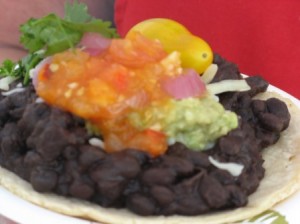
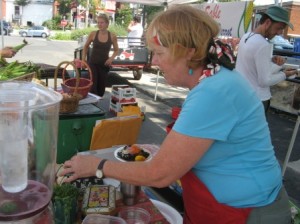 I may have just found out about her, but her reputation goes far. Another couple came up and said that the woman’s brother-in-law in North Carolina had heard of her, somehow coming across an article from one of the West Island newspapers. She had to try it and report back to said brother-in-law. Both she and her husband had huge smiles after tasting the pulled pork taco. I guess that would be a yes.
I may have just found out about her, but her reputation goes far. Another couple came up and said that the woman’s brother-in-law in North Carolina had heard of her, somehow coming across an article from one of the West Island newspapers. She had to try it and report back to said brother-in-law. Both she and her husband had huge smiles after tasting the pulled pork taco. I guess that would be a yes.